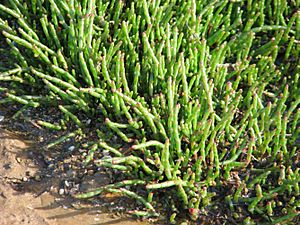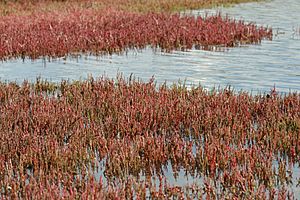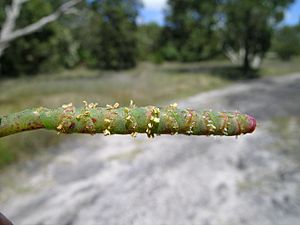Beaded glasswort facts for kids
Quick facts for kids Beaded glasswort |
|
|---|---|
 |
|
| At Ricketts Point Marine Sanctuary | |
 |
|
| at Sydney Olympic Park | |
| Scientific classification | |
| Subspecies | |
|
|
| Synonyms | |
|
Salicornia quinqueflora, also known as Sarcocornia quinqueflora, is a special plant. People often call it beaded samphire, bead weed, beaded glasswort, or just glasswort. It's a type of succulent shrub that loves salty places, like coasts. You can find it in wet coastal areas of Australia and New Zealand.
Long ago, people would burn glasswort plants. They did this to collect the ashes, which had a lot of soda. This soda was then used to make soap and glass. This is probably how the plant got its name, "glasswort"!
Contents
What is Beaded Glasswort?
Beaded glasswort (Salicornia quinqueflora) is a succulent plant, meaning it has thick, fleshy parts that store water. It can handle a lot of salt, which is why it grows near the ocean. This plant is a small shrub that lives for many years, which is called a perennial lifecycle.
You usually find it growing like a mat on the ground near salty water, such as along the coast or in estuaries. Its stems are jointed and feel soft and fleshy when they are young. As they get older, they dry out and become woody.
Plant Parts
Young stems are often grey or green, sometimes with red tips. The leaves grow in pairs, one on each side of the stem. They are connected at their base. These leaves grow on small, bumpy stalks called petioles. The leaves then extend down the stem, forming the noticeable joints.
The leaves look like tiny blades wrapped around the stem. This gives the stems a "beaded" look, which is how the plant got its common name! At the end of the stems, you'll find clusters of flowers called inflorescences. These are spiky and made of small parts with groups of flowers called cymes.
Each cyme usually has three tiny flowers hidden inside the fleshy part of the joint. These flowers can be male, female, or both. They are almost always the same size. The flowers have three or four fleshy outer parts, one or two stamens (which make pollen), and an ovary (which holds the seeds).
The plant produces many fruits in the outer part of the flower. The seeds are round, light brown, and hairy. They also have a thin outer layer. The hairs on the seeds can look different, like angled, curved, or straight.
How Beaded Glasswort Grows
Beaded glasswort plants are perennials. This means they can reproduce many times over their lives. They don't always need to make new seeds. Often, they make exact copies of themselves. This is called clonal propagation. They create new plants (called ramets) that are genetically identical to the parent plant. This helps them spread quickly.
When conditions are good, glassworts will produce genets. These are new, unique plants grown from seeds. This helps keep the plant population diverse and strong. Ramets often stay connected to the parent plant. This helps them survive in tough conditions until they are strong enough to live on their own. Seeds usually start to grow in early spring when the weather gets warmer.
Flowers and Pollination
Salicornia quinqueflora is special because it can have different types of flowers. Some groups of plants have only flowers that are both male and female (called hermaphrodites). Other groups have both female flowers and hermaphrodite flowers.
For the hermaphrodite flowers, the female parts mature before the male parts. This helps prevent the plant from fertilizing itself. The female part (the stigma) sticks out for a few days before the male part (the anther) releases pollen. The anthers open in the morning to release pollen, which is then carried by the wind.
These flowers do not make nectar, so insects usually don't pollinate them. However, sometimes honeybees have been seen visiting the flowers and collecting pollen. This means bees might help spread the pollen too. For female flowers, their stigmas appear at the same time as the hermaphrodite plants release pollen. This allows the female plants to be fertilized, starting the life cycle.
Plant Family and Names
This plant was first named Salicornia quinqueflora in 1866. Later, it was moved to a different group called Sarcocornia in 1977. However, recent studies using DNA analysis showed that Salicornia actually grew from within Sarcocornia.
Because of this, scientists decided in 2017 to put Sarcocornia back into the Salicornia group. This is now accepted by major plant databases. The Maori name for this plant is ureure.
Where Beaded Glasswort Lives
Global Homes
Salicornia quinqueflora is not just found in New Zealand. In New Zealand, it grows mostly along the shoreline in the North Island. In the South Island, it's common on the east coast but not on the west coast.
In Australia, you can find it in the southwest and southeast. It also grows in parts of the Nullarbor Plain and on the east coast of the Cape York Peninsula.
New Zealand Locations
In New Zealand, this plant is mainly found in coastal areas. It grows on all the main islands, including Stewart Island and the Chatham Islands. It's on both coasts of the North Island and down the east coast of the South Island.
Interestingly, it's also found in Central Otago, which is about 70 kilometers inland! This is unusual because it loves salty coastal areas.
Favorite Places to Grow
Beaded glasswort loves places where there's salty water. This includes coastlines, salt marshes, sandy beaches, and rocky areas. It grows both below and above the high tide mark along the coasts.
Soil and Environment
Since it's a halophyte, it prefers soils with a lot of salt. This is the most important thing for it to grow well. It's usually found in moist areas because of the salty soil near the coast. However, glassworts can handle many different soil wetness levels. They can grow in very dry soil or in soil that is completely waterlogged.
For example, it grows well in Otago, which is very dry. It also thrives on the very wet coastlines of Nelson. Like other salt-loving plants, Salicornia quinqueflora can handle many temperatures. It is good at adapting to sudden changes in its environment. Making copies of itself through cloning helps it survive when conditions are not perfect. It prefers warm-temperate and subtropical areas. In these places, it can easily reproduce using seeds to keep its populations strong.
Dangers to Beaded Glasswort
Invading Plants
When new plant species are brought into areas where beaded glasswort lives, it can cause problems. These non-native plants often grow faster than the native glasswort. This allows them to take over the glasswort's habitat.
For example, in Victoria, Australia, an invasive plant called Cordgrass (Spartina species) has changed coastal areas. It turned mudflats into marshlands. These mudflats were important for glasswort, so this change left the native glasswort without its home.
Glasswort Gall Mite
A tiny creature called the glasswort gall mite (Aceria rubifaciens) was found in Auckland in 1948. It was seen again in 2013 near the Firth of Thames. This tiny mite only eats glasswort. When it feeds, it causes small bumps, called galls, to form on the young stems. The mites live inside these galls, which protect them from bigger predators and bad weather.
Not much is known about these mites because they have only been found on Salicornia quinqueflora. So far, they have only been seen in the North Island of New Zealand.
Other Eaters
Glasswort is also edible, meaning both animals and humans can eat it. So, you could say that animals and humans are also "predators" of glasswort!
More About Beaded Glasswort
Inland Habitat in Otago
Salicornia quinqueflora has been found growing inland in Central Otago, specifically in the Maniototo Plain. This is strange because it usually likes salty soils near the coast. The Maniototo plain has very salty soils because it is extremely dry. As rocks break down, the soil becomes saltier. There isn't enough rain to wash the salt away. This makes the soil salty enough for glasswort to grow. Birds likely carried the seeds to this area, allowing the plant to grow far from the coast.
Food for Parrots
One animal that really depends on glasswort is the orange-bellied parrot (Neophema chrysogaster). This parrot is critically endangered, with only about 180 birds left in the wild. This Australian bird mainly eats the seeds of Salicornia quinqueflora. As places where glasswort grows disappear due to human activity, it becomes harder for these parrots to find enough food to survive.
Glasswort in Recipes
Besides being a tough plant that can grow in harsh conditions, glasswort is also edible! It's best to eat the fresh, young, upper parts of the stems. They are tender and have more flavor. You can eat glasswort on its own, like in a salad, or mix it with other salad ingredients.
It also makes a great garnish with seafood, similar to how parsley or watercress are used. Because it's naturally salty, glasswort is good for adding flavor to soups or stews. You can also serve it as a hot vegetable. With care, you can even pickle the fresh stems.
Glasswort also has some health benefits. It is high in Vitamin C, Vitamin A, and B-complex vitamins. Some people say it can help with digestion. It also contains natural compounds like quercetin and isorhamnetin, which are being studied for possible health benefits.
Images for kids
See also
 In Spanish: Sarcocornia quinqueflora para niños
In Spanish: Sarcocornia quinqueflora para niños




